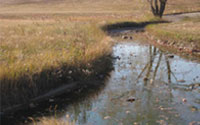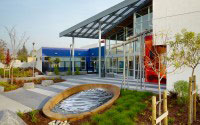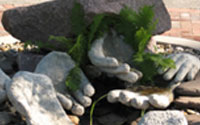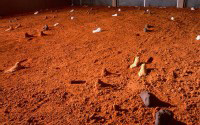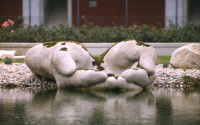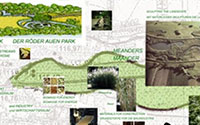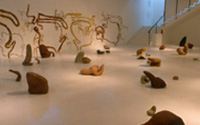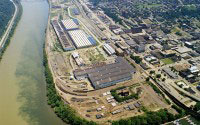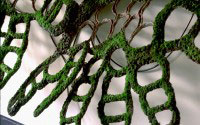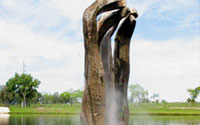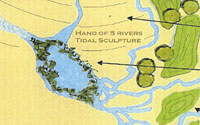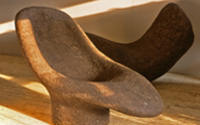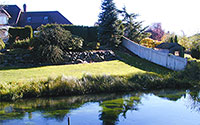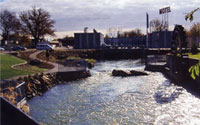THE FARGO PROJECT
 The goal of The Fargo Project is to transform an 18-acre stormwater detention basin into a multifunctional neighborhood commons through a fully participatory community process. This collaboration with The City of Fargo, residents of Fargo and a team of local artists, co-lead by myself and Fargo Senior Planner Nicole Crutchfield is intended to foster creative agency through a community-based approach to making this new outdoor space. Because the basin must maintain its function as a storm water collection site to prevent flooding from rainstorms, part of the exciting challenge of the project is designing other uses for it that can be compatible with and even enhance the basin’s infrastructure function. This place becomes the context to celebrate water as the source of all life and stormwater as a valuable resource.
The goal of The Fargo Project is to transform an 18-acre stormwater detention basin into a multifunctional neighborhood commons through a fully participatory community process. This collaboration with The City of Fargo, residents of Fargo and a team of local artists, co-lead by myself and Fargo Senior Planner Nicole Crutchfield is intended to foster creative agency through a community-based approach to making this new outdoor space. Because the basin must maintain its function as a storm water collection site to prevent flooding from rainstorms, part of the exciting challenge of the project is designing other uses for it that can be compatible with and even enhance the basin’s infrastructure function. This place becomes the context to celebrate water as the source of all life and stormwater as a valuable resource.
The project provides a unique opportunity for city residents of all ages and backgrounds to envision, design and build a place where they can connect with others and celebrate Fargo’s rich natural and cultural diversity. In addition to the majority population, Fargo is home to urban Native Americans from many different nations. Fargo also has a diverse population of “New Americans,” refugees and immigrants from over 20 countries including Bhutan, Somalia, Sudan, Liberia, Iraq, Bosnia, and many others. Fargo/Moorhead is also an academic research center.
Our primary efforts during the project’s first year were to create relationships with city residents of all ages and backgrounds to understand what kind of commons people want and speaking with natural resource and soil scientists to understand the research opportunities the site presents. Over several months our ecological artist team and other volunteers engaged over 400 people of all ages and backgrounds in the initial visioning outreach. The project team visited nearby residences and businesses, went into churches, had participatory events in the park, with the secondary schools, and in the high school, met individually and in small groups with New Americans from many cultures, with representatives from the Native American Community, and engaged with students and faculty from Fargo/Moorhead academic institutions.
Our first public event was a presentation by Linda Different Cloud, a Lakota ethnobotanist who provided insights about how traditional Wisdom can enrich The Fargo Project. Linda toured the site with the project team to share her recommendations about the potentials for establishing culturally important plants and ways in which the site could serve Fargo’s Native American community.
In late spring 2012 over 200 people participated in the celebration inaugurating the basin with Native American dancing and drumming and at the WeDesign workshop that followed. At the design workshop people worked out their ideas on maps or with our custom made sand models of the site and tool kit of props prepared by the artist team.
Once completed, the basin at Rabanus Park, Fargo’s largest and most visible basin, will feature 17 acres of restored native prairie meadow, walking trails, natural play areas and outdoor spaces for gathering and celebration.
![]() In 2014 The Fargo Project received a $450,000 grant from ArtPlace America. The project received an inaugural $100,000 “Our Town” matching grant from the National Endowment for the Arts in 2011. Riverkeepers, The Plains Art Museum and The Parks District are project partners.
In 2014 The Fargo Project received a $450,000 grant from ArtPlace America. The project received an inaugural $100,000 “Our Town” matching grant from the National Endowment for the Arts in 2011. Riverkeepers, The Plains Art Museum and The Parks District are project partners.
For more Information please visit these links:
City of Fargo website for The Fargo Project
NEA interview featuring The Fargo Project at inaugural announcement of “Our Town” grants
VEDEN TAIKA
Veden Taika (The Magic of Water) consists of three floating islands in Salo, Finland. The islands provide nesting habitat for birds and plant based filtration for improving water quality in the Salo Bird Pools, lagoons that were formerly used in the sewage treatment processes of the Salo Municipal Sewage Treatment Facility. Because an abundance of migrating and nesting birds now use the lagoons, the pools have been established as an EU-directive conservation site. The birds need nesting areas separated from surrounding land to protect the eggs and young birds from predators. Analyses of the sediment at the bottom of the Bird Pools revealed residues of oils and fatty organic pollutants, as well as some heavy metals, the legacy of the former uses of the pools.
The largest island (7.45m x 28m) provides nesting habitat while the two smaller islands (11.45m x 6m) contain plants for phytoremediation. These islands are vegetated with plants specially chosen to remove pollutants from the water and sediments, completing the cycle of transformation that began years ago with the sewage treatment process.
During the warm months a cloud of mist rises up over the islands several times a day. An aerator beneath the islands oxygenates the water and stimulates microbial processes on the plant roots to encourage microbial diversity.
Veden Taika is a collaboration with local volunteers, regional science experts, the students and faculty of the Salo Polytechnic Institute, the Salo Parks Department and Office of Environmental Protection. Biomatrix Water and the superb coordination of artist Tuula Nikulainen.
URBAN RAIN
The Roosevelt Community Center in San Jose, A, a LEED gold building, was completed in Fall, 2008. My two installations here detain and filter storm water runoff from the roof.
On the North side of the building, two water chutes channel the stormwater from the scupper and drop it onto the Thumbprint filter, a stainless steel sculpture based on the spiral forms of fingerprints, water and galaxies. The sculpture aerates the water as it drops into the rock basin below, where it is detained and filtered before flowing into a bioswale. A concrete seating wall surrounds the sculpture and contains a layer of.filtration rock that is two feet deep. This volume is large enough to detain and filter runoff from 5700 sq. ft. of roof area for a .5 inch storm.
The Coyote Creek Filter, on the South side of the building, is a translucent rock filter that allows the infiltration processes that usually happen underground to be visible. It consists of an amber glass and stainless steel rock filter system, a stainless steel panel offset in front of it, and a 27 foot long planter. In order to suggest the link between stormwater runoff and nearby Coyote Creek, a map of the Coyote Creek watershed is etched into the glass and cut out of the stainless steel panel. It connects what appears to be separate, as all watersheds do. The filter is large enough to detain and filter runoff from 7800 sq. ft. of roof for a .5 inch storm. It is illuminated from behind at night.
The book “Urban Rain,” published by ORO editions in 2009, documents the entire process of this award winning project from its conceptual foundations to completion, and sets it within the context of my previous work with urban stormwater.
Photo Credits: copyright © Cesar Rubio 2008 | #1,2,3,4,5,6,7,8,10,11,12
LAUGHING BROOK
Salway Park is one of the pilot projects for the Mill Creek Greenway system in Cincinnati, Ohio. I worked with the Mill Creek Restoration Project and Human/Nature landscape architects in partnership with the Cincinnati Parks and Recreation Commissions and the Cincinnati Contemporary Arts Center to create Laughing Brook. This park, a series of playing fields serving lower income communities, is situated next to Mill Creek, one of North America’s most endangered rivers. Laughing Brook filters stormwater runoff from 3 acres of parking lots, sidewalks and ballfields before the water enters the river.
Laughing Brook is a stream of 106 biosculptures in constructed wetland habitats that creates a community gathering area and focal point for park users, while demonstrating sustainable urban stormwater practices. Stormwater runoff is gathered in a small plaza, where it seeps through porous paving to collect in an underground cistern. It is then pumped over the biosculptures and through the wetlands until the next heavy rains, when the filtered water is released into the river. The pumps and irrigation system are solar powered. Walkways meander over the wetland stream and Biosculptures, surrounded by prairie landscapes, butterfly gardens and native plant nurseries.
We worked with the neighboring communities to plan, build, and maintain the project. In Summer 2004, I worked with local artists Tony Luensman and Gordon Strain and a group of local high school students through the Artworks program to cast over 100 concrete biosculptures.
The biosculptures start out as hands and in a kind of reverse evolution gradually transform into 6 species of fish that would be live in Mill Creek if it waters were healthy. They provoke the question, “What is the being of human?”
OF EARTH AND COTTON
Of Earth and Cotton traveled from 1994 to 1998, evolving at it crossed the southern United States, following the westward migration of the cotton belt. At each of seven locations from the Carolinas to Texas, I spoke with people who farmed and picked cotton by hand in the 1930’s and 40’s. As they spoke about their memories, I sat on the ground sculpting portraits of their feet out of nearby soil. The foot portraits became the focal points of large installations where they rested on 60 tons of soil or 2500 pounds of ginned cotton. Made of many different colors and textures of soil, the portraits were a metaphor for all the soils that were worked and the diversity of peoples who worked them.
Accompanying the installations were forty photographs from the 1930’s that depict living and working conditions of cotton farmers during the Depression and a video by Terry Iacuzzo that documents my conversations with the former cotton farmers. The photographs were commissioned by the US Government for the Farm Security Administration.
This project was developed in collaboration with curator and photographic historian Susan Harris Edwards. Of Earth and Cotton was featured on the CBS Sunday Morning Show in March 1996.
Of Earth and Cotton traveled to:
McKissick Museum, Columbia, SC (1994)
Diggs Gallery, Winston Salem State University, NC (1995)
The Hunter Museum of Art, Chattanooga, TN (1995)
The Columbus Museum, Columbus, GA (1995)
University of North Texas Art Gallery, Denton, TX (1996)
The National Civil Rights Museum, Memphis, TN (1996)
Gallery 210, University of Missouri, St. Louis, MO (1998)
UPDATE:
Of Earth and Cotton has been gifted to and can be seen at the National Civil Rights Museum at 450 Mulberry Street, Memphis, Tennessee 38103.
www.civilrightsmuseum.org
THE GIFT OF WATER
3 x 5 x 9’
This biosculpture was commisioned by the town of Grossenhain, near Dresden, Germany. Water, as a symbol of renewal, figured prominently in the town plan to build a remarkable new public swimming complex, where the water is filtered entirely by wetland plants, without the use of chlorine or any other chemicals.
The Gift of Water functions as a part of this constructed wetland filtration system. Two mossy cupped hands reach from the bank into the pond. As water flows into the hands a misting fountain aerates it and moistens the mosses, which in turn, purify the water. The intimacy of the mosses growing over the hands exemplifies how all life is interconnected. The gift of water, the breath of life. We must nurture it as it nurtures us.
The sculpture is built of a lightweight, highly durable textile reinforced concrete developed at the Technical University in Dresden, and was made with their assistance.
PRIMA LINGUA
64 x 101 x 80″
Concrete, volcanic rock, mosses, ferns,
wetland plants, fish, steel
(First Language/First Tongue) is a monstrously large tongue that licks the polluted water in which it stands. The mosses, liverworts and other plants that live on the surface are a fascinating microcosm that help clean air as well as filter the water. Mosses are extremely efficient biochemical filters that are capable of absorbing even heavy metals, while the porous concrete substructure physically removes particulates. Fish, snails, and plants live in the water that is pumped over the tongue. The piece is a visible image of transformation, revealing decay as part of creation.
Prima Lingua is permanently installed in La Plaza Cultural Community Garden located on East 9th Street & Ave C in Manhattan.
VISIONS FOR THE RIVER RÖDER
Invited to propose solutions for public space in a rural flood plain near Dresden, Germany, Jackie Brookner conceived a plan for a multifunctional wetland park that would serve aesthetic, recreational, cultural, ecological, and agricultural needs–with walking and bike trails, restored habitat areas for amphibians and birds, and wetlands, meadows and sculpted berms to absorb floodwaters. The spiraling wetlands and walkways surround demonstration sites for wetland agriculture that would provide resources for sustainable textile products and research for sustainable wetland agriculture for the adjoining two and a half mile flood plain. Renewing the area’s long and now defunct textile tradition could help reduce the region’s staggering unemployment.
NORTH RIVERFRONT PARK
North Riverfront Park was a community-based, landscape-scale project intended to enrich the experience of community residents and visitors to the Mississippi River and positively affect the watershed by remediating the massive volumes of stormwater runoff that flow through the site before it goes into the River. This project was designed to activate creative agency through a deep community process, wherethe concept, design and entire process of bringing the project to fruition were to come from the collective decision making of a diverse community of participants and stakeholders. I conceived the project, and co-led it with landscape architect Rick Kacenski from HOK.
There were several reasons the 250-acre North Riverfront Park was chosen as the site. First is its superb location. The park sits on the bank of the Mississippi and provides direct access to the river. The municipal water treatment plant that provides the city’s drinking water is at the north end of the park. In addition the City of St. Louis Parks Department was embarking on a master planning process for the Park and the neighboring community was actively concerned with how the site would be used.
The process began with a public design workshop at North Riverfront Park. Over the next two months we worked with neighborhood residents, graduate students from Washington University, high school student apprentices with St. Louis ArtWorks, technical advisors and other interested citizens to develop a conceptual plan. The graduate students and Artworks apprentices presented their proposals and received ongoing review and critique for their developing ideas from the residents and stakeholders at additional public meetings.
The ideas generated through this collaboration were shared with the master planners and fully incorporated into the official city master plan for the park. Fruition of the project awaits funding. The project was a collaboration between The Confluence Partnership, Washington University’s Sam Fox School of Design and Visual Arts, and St. Louis ArtWorks.
NATIVE TONGUES
Native Tongues was a sound, sculpture and drawing installation that took place at the Miro foundation in Barcelona in 1997. It gave me the opportunity to explore relationships between speech, language and soil. In Catalonia, where the Catalan language was officially silenced for much of this century, language is fraught with issues of homeland, territory and power. Within this context, I wanted to underline the corporeality of speech–to see language as an event of mind and body. For this project I listened to the sounds of the Castillian (Spanish) and Catalan languages, and then imagined the shapes of the Tounges that would speak these sounds. I then made the Tounges from soils I collected in Spain–the Castillian Tounges from soils from central Spain, the Catalan Tounges from the soils of Catalonia.
The fifty foot wall drawing was made from these same soils and is based on phonetics diagrams that map where the tongue is placed to make specific sounds. I was drawn to these diagrams because they look so much like maps of estuaries.
The installation also included two sound tracks. From near the ground one heard the layered voices of many conversations being spoken in various dialects and accents of Spanish and Catalan. In counterpoint to this, high in the room, were two very formal male voices speaking basic words, first in one language, then in the other.
ENVISIONING MCKEEPORT
McKeeesport is a post-industrial city near Pittsburgh, at the confluence of the Youghiogheny and Monongahela Rivers. It has been economically depressed since the decline of the steel industry. To help McKeesport imagine itself as a thriving place where people want to work and live, and to instill local pride about rich natural and social resources, we created a fictional tourist brochure set in 2020, after McKeesport had won the coveted 2018 Urban Conservation Excellence Award.
We also provided a conceptual plan with step-by-step phasing to realize the vision. The plans include a trail system integrating historical and industrial buildings with ecological and economic revitalization; a new park that will celebrate the confluence of the two rivers and Mckeesport’s rich history, and will demonstrate sustainable watershed practices; as well as a youth job training program that will create new skills for local youth, from building to ecological restoration.
I’M YOU
67 x 112 x 50”
Moss, volcanic rock, cement, water, plants, fish,
snails, rubber pond liner, tubing, pumps.
The image of this biosculpture™ is based on microscopic structures called lamellae that are found in some mosses. Their uncanny resemblance to human hands is a playful reminder that we humans are part of larger natural patterns.
The final image is a proposal for a large outdoor wall sculpture that will filter stormwater runoff from the roofs of adjacent building. It is based on these same microscopic moss structures.
DREHER PARK
In 2003-2004 the City of West Palm Beach redesigned its premier park, 130 acre Dreher Park, to improve stormwater capacity and enhance recreation areas. Artist team Jackie Brookner and Angelo Ciotti were commissioned to work on art concepts throughout the park and be part of the Design Team.
Brookner and Ciotti created Elders’ Cove, a landscape complex that includes a fourteen foot biosculpture, that uses wetland plants to filter water in one of the park’s new lakes, a viewing dock, wetland habitats, and sculpted mounds that reclaim excavated soil. Other of their concepts include cypress swamp islands that recall the original Everglades ecosystem of the site, a medicinal garden based on Seminole culture designed in consultation with Seminole elders, and native plant restoration.
BIOSCULPTURES™
Biosculptures™ are living sculptures that use the capacity of carefully chosen plants to clean and filter water. Made of mosses, ferns and other plants growing on stone and concrete structures, they provide ecological and aesthetic solutions to water quality and water quantity problems.
Biosculptures™ are biogeochemical filters that work as parts of natural water treatment systems, and demonstrate how there is no waste in healthy natural systems. Rather, the “waste” of one organism becomes food for another. As water flows over the sculptures, the plants and associated bacteria transform pollutants and toxins into life sustaining nutrients. Fish, snails, and other aquatic organisms live in the water and enrich these sculpted ecosystems.
These vegetated sculptures are intended to seed a sense of connection to worlds beyond the human and to encourage understanding that is it possible to sustain human life in ways that benefit natural systems, rather than degrade them. In these projects art is a visible catalyst to foster sustainable watershed practices through community participation, environmental education, and ecological restoration.
HOQUARTEN INTERPRETIVE TRAIL
The team of Jackie Brookner and Susan Steinman was awarded the 2002 Art and Community Landscapes commission to be Artists-in-Residence with the National Park Service Rivers and Trails Program in the Northwest region. Art and Community Landscapes was a partnership of the National Endowment for the Arts, the National Park Service and the New England Foundation for the Arts that supported site-based public art as a catalyst for action at the community level.
In 2002-3 they worked in Caldwell, ID, Tillamook, OR and Puyallup, WA, providing consultation and preliminary planning, and building community support for each town’s waterway project. With extensive outreach across stakeholder and community groups, they built many new partnerships, created local public art initiatives, started now annual river and trail festivals, and helped design conceptual plans for river daylighting, stream restoration and trails.
In Tillamook, OR Brookner and Steinman worked with local residents to design and build support for The Hoquarten Interpretive Trail. The focus of the trail is Hoquarten Slough, which once served as a water route for fishermen entering the city from the Pacific Ocean, and provided hunting and fishing grounds for the Tillamook Indian Tribe. The four mile trail along the banks of the slough will connect the city with the bay, will provide pedestrian and bike paths, and economic opportunities for the town.
TONGUE CHAIRS
Since 1992 I have been making tongues out of soil. Some of these evolved into chairs, where earth can embrace the whole body. The tongue is a provocative image because it is a part of our selves where our physical and mental functions come together–a place where taste, sex and speech meet–where the dualism of mind and body clearly breaks down.
CLARK’S CREEK GREENWAY
The team of Jackie Brookner and Susan Steinman was awarded the 2002 Art and Community Landscapes commission to be Artists-in-Residence with the National Park Service Rivers and Trails Program in the Northwest region. Art and Community Landscapes was a partnership of the National Endowment for the Arts, the National Park Service and the New England Foundation for the Arts that supported site-based public art as a catalyst for action at the community level.
In 2002-3 they worked in Caldwell, ID, Tillamook, OR and Puyallup, WA, providing consultation and preliminary planning, and building community support for each town’s waterway project. With extensive outreach across stakeholder and community groups, they built many new partnerships, created local public art initiatives, started now annual river and trail festivals, and helped design conceptual plans for river daylighting, stream restoration and trails.
In Puyallup, we worked to support plans for the Clark’s Creek a greenway corridor. Clark’s Creek emerges from artesian springs and flows two miles to its confluence with the Puyallup River. The greenway addresses water quality and flood control issues, provide public access to the watershed, and create opportunities for public-private interests in watershed stewardship.
We worked with local primary school art and science programs to produce the “I am Clark’s Creek “ booklet. Told from the creek’s point of view, it encourages healthy watershed practices for homeowners along the Creek.
INDIAN CREEK DAYLIGHTING PROJECT
The team of Jackie Brookner and Susan Steinman was awarded the 2002 Art and Community Landscapes commission to be Artists-in-Residence with the National Park Service Rivers and Trails Program in the Northwest region. Art and Community Landscapes was a partnership of the National Endowment for the Arts, the National Park Service and the New England Foundation for the Arts that supported site-based public art as a catalyst for action at the community level.
In 2002-3 they worked in Caldwell, ID, Tillamook, OR and Puyallup, WA, providing consultation and preliminary planning, and building community support for each town’s waterway project. With extensive outreach across stakeholder and community groups, they built many new partnerships, created local public art initiatives, started now annual river and trail festivals, and helped design conceptual plans for river daylighting, stream restoration and trails.
In Caldwell, ID Brookner and Steinman worked with community members, stakeholders and the National Park Service team to create support for daylighting Indian Creek. Restoring a 900 foot stretch of Indian Creek that flows under Caldwell’s business district was the focal point of downtown revitalization. Uncovering the Creek, capped and piped since the 1950’s, has provided recreational, educational, and environmental opportunities, helped spur economic vitality and create a healthier community. Brookner and Steinman worked closely with local artists Ignacio Ramos and Juan Martinez, Caldwell Fine Arts and the Hispanic Cultural Center to create Caldwell’s first public art, a tile mural and steel sculpture both celebrate the life of Indian Creek. We also worked with many other groups to initiate and plan the first annual Indian Creek Festival.
